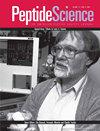From Protein to a Bioactive Peptide: Potent IL‐6 Peptide Antagonist Generated by a Novel Method
IF 1.7
4区 生物学
Q4 BIOCHEMISTRY & MOLECULAR BIOLOGY
引用次数: 0
Abstract
Here, we describe a new technology, designed to accelerate peptide discovery by quick identification and optimization of the residues critical for protein–protein interactions or ligand binding. We called it PepFusion. It is based on ligation of short DNA sequences generated from known ligand‐binding regions. We tested it by selecting peptide antagonists of interleukin‐6 (IL‐6), a key mediator of inflammatory diseases such as rheumatoid arthritis (RA), Crohn's disease, and Castleman disease (CD). The PepFusion library demonstrated superiority over a random library by yielding a peptide with low micromolar affinity for IL‐6, whereas the random library failed. The affinity of the peptide from the PepFusion library was further enhanced by additional rounds of mutagenesis leading to peptide variants with low nanomolar IL‐6 affinity. In addition to generating high‐affinity peptides, our method opens the way to solve the problem of the false positive sequences, which are common with all display technologies.从蛋白质到生物活性肽:用一种新方法生成的强效 IL-6 肽拮抗剂
在这里,我们介绍一种新技术,旨在通过快速识别和优化对蛋白质-蛋白质相互作用或配体结合至关重要的残基,加速多肽的发现。我们称之为 PepFusion。它基于从已知配体结合区域生成的短 DNA 序列的连接。我们通过选择白细胞介素-6(IL-6)的多肽拮抗剂对其进行了测试,IL-6是类风湿性关节炎(RA)、克罗恩病和卡斯特曼病(CD)等炎症性疾病的主要介质。与随机文库相比,PepFusion 文库的优势在于能产生对 IL-6 具有低微摩亲和力的多肽,而随机文库则失败了。PepFusion 文库中多肽的亲和力通过多轮诱变得到进一步提高,从而产生了具有低纳摩尔 IL-6 亲和力的多肽变体。除了生成高亲和力的多肽外,我们的方法还为解决假阳性序列问题开辟了道路,而假阳性序列是所有显示技术的通病。
本文章由计算机程序翻译,如有差异,请以英文原文为准。
求助全文
约1分钟内获得全文
求助全文
来源期刊

Peptide Science
Biochemistry, Genetics and Molecular Biology-Biophysics
CiteScore
5.20
自引率
4.20%
发文量
36
期刊介绍:
The aim of Peptide Science is to publish significant original research papers and up-to-date reviews covering the entire field of peptide research. Peptide Science provides a forum for papers exploring all aspects of peptide synthesis, materials, structure and bioactivity, including the use of peptides in exploring protein functions and protein-protein interactions. By incorporating both experimental and theoretical studies across the whole spectrum of peptide science, the journal serves the interdisciplinary biochemical, biomaterials, biophysical and biomedical research communities.
Peptide Science is the official journal of the American Peptide Society.
 求助内容:
求助内容: 应助结果提醒方式:
应助结果提醒方式:


